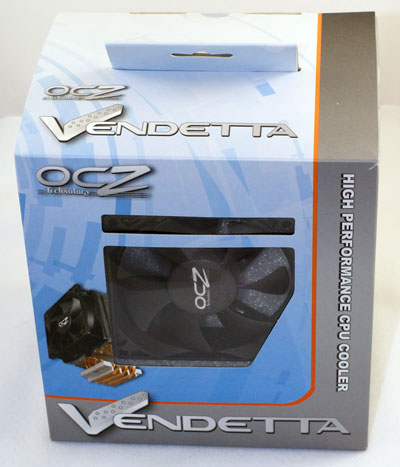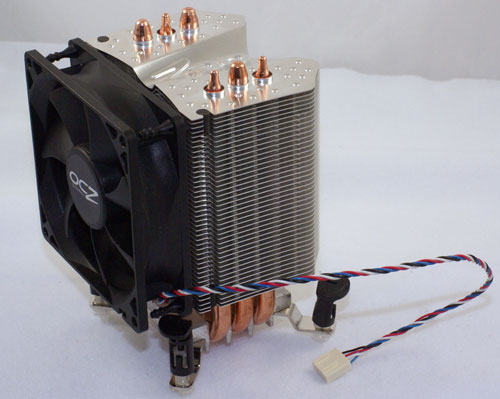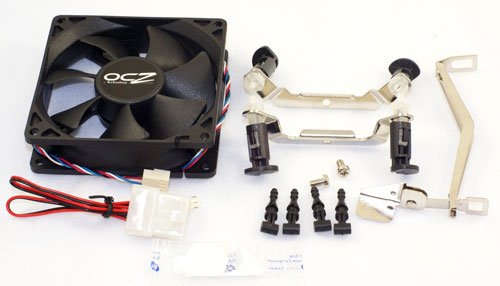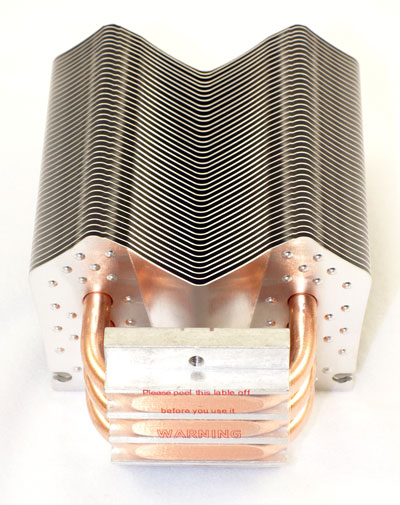New Mid-Priced Coolers from OCZ and Scythe: The Small and the X of It
by Wesley Fink on October 1, 2007 12:05 AM EST- Posted in
- Cases/Cooling/PSUs
OCZ Vendetta
OCZ is a name that comes to mind whenever you discuss solutions for computer enthusiasts. In the past the first picture that cropped up when OCZ was mentioned was top-line memory, but in the last few years OCZ has led a movement to diversify to other computer enthusiast offerings.
This started with OCZ power supplies which became leaders in the power supply market and culminated with the acquisition of PC Power and Cooling, which is another well-respected line of enthusiast power supplies. OCZ has also been active in RAM cooling, video cards, coolers, thermal grease, and many other products for the enthusiast.
Coolers are not really a new thing for OCZ, but you do have to reach back a few years when OCZ marketed some of the top coolers. Recently OCZ has made efforts to again become recognized in the cooling market. The Vendetta is a brand new air cooler from OCZ. In fact it is so new that it is difficult to find anyone selling it to get an idea of selling price. However, it appears the street price will be somewhere around $30, which lands it in the midrange of air coolers.

We're accustomed to seeing OCZ orange on their packaging and it's still there as a stripe, but the Vendetta is mainly a sky blue and grey package. In line with other OCZ products, packaging for the Vendetta is simple and straightforward - providing the basic info a buyer might need but without trying to cram everything possible on the box

Inside the package the small Vendetta cooler is well protected by formed foam. The cooler is based on a Xigmatek design and is much smaller than the normal 120mm fan heatpipe tower. The fan is just 92mm in this design and OCZ makes no provisions at all for mounting a larger fan.

Accessories are included that allow the Vendetta to mount to Intel Socket 775 or AMD Socket 754/939/AM2. All that's needed is to attach the mount - very easy with just two screws needed - and attach the 92mm fan.

Of course the problem with smaller fans is that they are often very loud for the air they actually can move compared to large fans. OCZ tries to address this potential issue beginning with the innovative elastomeric mounts used to attach the fan. The plugs fit in slots on the side of the cooler and slits in the elastomer strap fit over "the third fin from the top and the third from the bottom" according to the well-written instructions.

The mounting side has flattened heatpipes that feature "Heatpipe-to-CPU Direct Contact". OCZ seems to imply these might cool better than heatpipes embedded in a mounting base.
Specifications
The OCZ Vendetta is very flexible in supporting Intel Socket 775 and AMD 754/939/AM2. Mounting hardware is included for all supported sockets.
You might want to carefully compare the dimensions of the Vendetta to other tower coolers tested at AnandTech. It really is quite small and relatively lightweight. The cooler also features the 4-pin PWM fan connector, which allows the BIOS settings to control how the adjustable speed fan operates. The fan is rated at 1200-2800 RPM, which is a very broad speed range.
Installation
Attaching the mount is a 2-screw snap, and the fan attaches with the elastomeric strips. Installation is then down to those irritating push-pins on the Intel 775 mount. The push-pins are bad enough, but the ones on the Vendetta mount move all around in their attachment to the mount. This means you have to carefully align the pins so you don't mutilate them while installing.
That's really a shame since the cooler is small enough that you can normally operate the pins with the motherboard mounted - even though some of the pins are still overhung by the cooler. There is the additional step of fiddling with the pin in the hole to make sure the pin will go in straight and not bend. Normal push-pins are bad enough, but we would welcome some push-pins in this mount that don't move all around during mounting.
One suggestion is to mount the heatsink before attaching the fan as it simplifies fiddling with the push-pins. Once mounted with a reassuring click (times four), the Vendetta is solidly attached and very secure on the motherboard, in either horizontal or tower configuration. You can then attach the small fan, plug in the PWM connector, and power up.
OCZ is a name that comes to mind whenever you discuss solutions for computer enthusiasts. In the past the first picture that cropped up when OCZ was mentioned was top-line memory, but in the last few years OCZ has led a movement to diversify to other computer enthusiast offerings.
This started with OCZ power supplies which became leaders in the power supply market and culminated with the acquisition of PC Power and Cooling, which is another well-respected line of enthusiast power supplies. OCZ has also been active in RAM cooling, video cards, coolers, thermal grease, and many other products for the enthusiast.
Coolers are not really a new thing for OCZ, but you do have to reach back a few years when OCZ marketed some of the top coolers. Recently OCZ has made efforts to again become recognized in the cooling market. The Vendetta is a brand new air cooler from OCZ. In fact it is so new that it is difficult to find anyone selling it to get an idea of selling price. However, it appears the street price will be somewhere around $30, which lands it in the midrange of air coolers.

We're accustomed to seeing OCZ orange on their packaging and it's still there as a stripe, but the Vendetta is mainly a sky blue and grey package. In line with other OCZ products, packaging for the Vendetta is simple and straightforward - providing the basic info a buyer might need but without trying to cram everything possible on the box

Inside the package the small Vendetta cooler is well protected by formed foam. The cooler is based on a Xigmatek design and is much smaller than the normal 120mm fan heatpipe tower. The fan is just 92mm in this design and OCZ makes no provisions at all for mounting a larger fan.

Accessories are included that allow the Vendetta to mount to Intel Socket 775 or AMD Socket 754/939/AM2. All that's needed is to attach the mount - very easy with just two screws needed - and attach the 92mm fan.

Of course the problem with smaller fans is that they are often very loud for the air they actually can move compared to large fans. OCZ tries to address this potential issue beginning with the innovative elastomeric mounts used to attach the fan. The plugs fit in slots on the side of the cooler and slits in the elastomer strap fit over "the third fin from the top and the third from the bottom" according to the well-written instructions.

The mounting side has flattened heatpipes that feature "Heatpipe-to-CPU Direct Contact". OCZ seems to imply these might cool better than heatpipes embedded in a mounting base.
Specifications
The OCZ Vendetta is very flexible in supporting Intel Socket 775 and AMD 754/939/AM2. Mounting hardware is included for all supported sockets.
| OCZ Vendetta Specifications | |
| Dimensions | 79(W) x 97(D) x 134mm(H) |
| Weight | 530g (18.7ounces) |
| Material | Copper heatpipes and aluminum fins |
| Configuration | 6 copper heatpipe tower with direct contact copper heatpipes |
| OCZ 92mm Fan Specifications | |
| Fan Size | 92mm x 92mm x 25mm |
| Fan Type | Ball Bearing |
| Rated Voltage | 12V |
| Fan Connector | 4-pin with PWM |
| Fan Speed | 1200-2800 RPM |
| Maximum Noise Level | 22.0 to 34.0 dBA |
| Airflow | 39.0 to 54.6 CFM |
You might want to carefully compare the dimensions of the Vendetta to other tower coolers tested at AnandTech. It really is quite small and relatively lightweight. The cooler also features the 4-pin PWM fan connector, which allows the BIOS settings to control how the adjustable speed fan operates. The fan is rated at 1200-2800 RPM, which is a very broad speed range.
Installation
Attaching the mount is a 2-screw snap, and the fan attaches with the elastomeric strips. Installation is then down to those irritating push-pins on the Intel 775 mount. The push-pins are bad enough, but the ones on the Vendetta mount move all around in their attachment to the mount. This means you have to carefully align the pins so you don't mutilate them while installing.
That's really a shame since the cooler is small enough that you can normally operate the pins with the motherboard mounted - even though some of the pins are still overhung by the cooler. There is the additional step of fiddling with the pin in the hole to make sure the pin will go in straight and not bend. Normal push-pins are bad enough, but we would welcome some push-pins in this mount that don't move all around during mounting.
One suggestion is to mount the heatsink before attaching the fan as it simplifies fiddling with the push-pins. Once mounted with a reassuring click (times four), the Vendetta is solidly attached and very secure on the motherboard, in either horizontal or tower configuration. You can then attach the small fan, plug in the PWM connector, and power up.










22 Comments
View All Comments
Wesley Fink - Monday, October 1, 2007 - link
There is only one game available that may possibly perform better with a quad CPU. Our original thinking was that we would wait to move to quad testing until games are launched that give us a reason to buy a quad-core - somewhere in the future.However, the point is well-taken that quads do generate more heat than dual-core processors, so we will be doing a comparison in the next few weeks on a range of coolers tested on a quad-core CPU.
Acanthus - Monday, October 1, 2007 - link
That is fantastic, not all of us buy quads for gaming :DI have one for encoding.
strikeback03 - Tuesday, October 2, 2007 - link
same here, though it would be nice if Premiere would make use of more than one core.Spacecomber - Monday, October 1, 2007 - link
The graphs and the discussion of them seemed out of synch, especially on page 5. It's as if the chart being discussed didn't get included or the discussion is meant for another section.Anyway, I got confused at that point, just looked at the graphs, and drew my own conclusions from there on. ;-)
Wesley Fink - Monday, October 1, 2007 - link
The Intel Retail results on p.5 had not been updated for CoreTemp results. That has now been updated. Hopefully the commentary now matches the graphs.Spacecomber - Monday, October 1, 2007 - link
Yup, the previous bar for the intel heatsink said something like 41 deg, which left me scratching my head.The discussion of how the cooling scaled with higher clock speeds also seemed out of place on that page, since there is no graphical representation of that until you get to page 7. Perhaps you were just making those comments paranthetically on page 5, but I wasn't clear why it was being discussed where all the results being graphically presented were for default clock speeds.
FrankThoughts - Monday, October 1, 2007 - link
...that took one look at the Scythe "I'm an X! Isn't that AWESOME!" design and immediately figured performance was going to suck? Repeat after me: gimmicky cooler designs do NOT work well! Just look at the first image of the cooler: all the closely packed fins, lots of gap between the fan and the fins, and you can already guess that most of the air so going to go around the fins rather than through them.Maybe a plastic shroud around the HSF would have helped, but even then a large amount of air would just go through the center gap. This is one of those designs that looks nifty but has some bassackwards thermodynamic "theory" at its core.
strikeback03 - Tuesday, October 2, 2007 - link
I'm just surprised they let something out that sucks this bad. If the performance were at least a little better than stock some might buy it for the looks, but this performance is just embarrassing to Scythe.puffpio - Monday, October 1, 2007 - link
I agreeYou can immediately look at it and see that the air the fan blows is going to go AROUND the heat sink...basic fluid dynamics..path of least resistance
But also w/ the OCZ cooler, they cut out some heat sink fins to make a curve shape...so you loose thermal capacity and gain aesthetics?
Someone needs to design an enthusiast heat sink and fan that consulted a thermal and aerodynamic engineer...perhaps tapping into the skill set of people who design car radiators..
KazenoKoe - Wednesday, October 3, 2007 - link
I would like to know how the Scythe cooler performs with 2 smaller fans, one for each heatsink, instead of one fan at an odd angle.